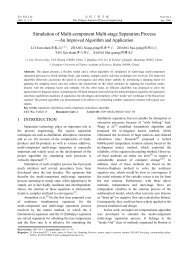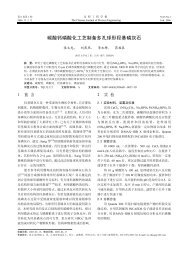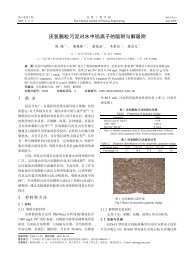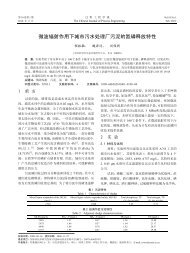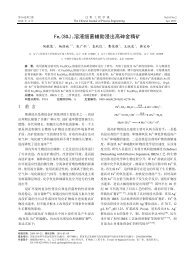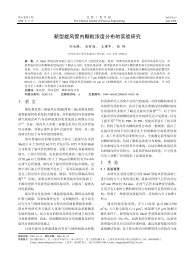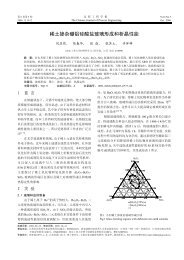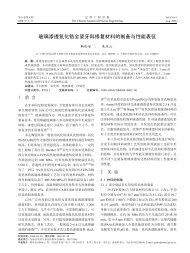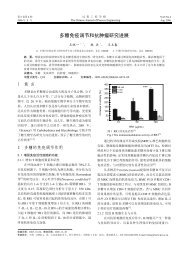Bioorganic Municipal Waste Management to Deploy a Sustainable ...
Bioorganic Municipal Waste Management to Deploy a Sustainable ...
Bioorganic Municipal Waste Management to Deploy a Sustainable ...
You also want an ePaper? Increase the reach of your titles
YUMPU automatically turns print PDFs into web optimized ePapers that Google loves.
第 6 卷第 2 期 过 程 工 程 学 报 Vol.6 No.2<br />
2006 年 4 月 The Chinese Journal of Process Engineering Apr. 2006<br />
<strong>Bioorganic</strong> <strong>Municipal</strong> <strong>Waste</strong> <strong>Management</strong> <strong>to</strong> <strong>Deploy</strong> a <strong>Sustainable</strong><br />
Solid <strong>Waste</strong> Disposal Practice in China<br />
Bernhard Raninger 1 , Werner Bidlingmaier 2 , LI Run-dong(李润东) 3 , FENG Lei(冯磊) 3<br />
[1. Mining University Leoben, A–8700, Leoben, Austria; CIM, D- 60325 Frankfurt am Main, Germany;<br />
2. Int. Transfer Center Environ. Technol., Inst. at Bauhaus Univ. Weimar, Weimar D-99423, Germany;<br />
3. Inst. Clean Energy & Environ. Eng. (ICEEE), Hangkong University, Shenyang, Liaoning 110034, China]<br />
Abstract: The utilization of bioorganic municipal waste (BMW) is considered essentially for the further development of<br />
integrated waste management practice in China. Awareness and knowledge about the importance of BMW management and<br />
source separation of waste on household level, as a precondition for the implementation of an economically feasible integrated<br />
waste management infrastructure, were developed in Europe during the last decade. The Sino–German RRU−BMW Project is<br />
facilitating applied research investigations in 4 pilot areas in Shenyang <strong>to</strong> assess the population’s behavior <strong>to</strong> develop the<br />
design criteria for appropriate process technologies and <strong>to</strong> provide the basis <strong>to</strong> adopt BMW management policy in China.<br />
Keywords: bioorganic municipal waste; bioorganic municipal waste management; sustainable development; primary source<br />
separation; clean compost; biogas<br />
CLC No.: X705 Document Code: A Article ID: 1009−606X(2006)02−0255−06<br />
1 INTRODUCTION<br />
In China in 2003, 146 million metric <strong>to</strong>ns of<br />
municipal solid waste (MSW) were collected in 660<br />
cities from about 338 million citizens (26% of China's<br />
<strong>to</strong>tal population) with a clearly increasing tendency. For<br />
example, Shanghai is gathering 16000 t of MSW daily<br />
and in Shenyang the amount is about 5000 t/d. All over<br />
the country about 80% of the collected MSW is disposed<br />
off in low standard dumping sites without prior<br />
processing or any other measures <strong>to</strong> lessen the<br />
environmental impact. This leads <strong>to</strong> local and even<br />
global ecological threads, caused by leachate and landfill<br />
gas emissions (approximately 3% of global<br />
anthropogenic CH4 emissions are deriving from MSW<br />
landfills contributing <strong>to</strong> climate change).<br />
The specific MSW production in China is related <strong>to</strong><br />
0.8~1 kg/(capita . d) [or about 300 kg/(capita . a)]. In China<br />
in 2003 there are 574 solid waste treatment plants and<br />
engineered disposal sites in operation. These facilities<br />
have a <strong>to</strong>tal capacity of 73 Mt/a (219000 t/d)<br />
corresponding <strong>to</strong> a treatment rate of 49.7% of <strong>to</strong>tal waste<br />
collected. The course of waste collection and treatment<br />
capacities is shown in Fig.1. It is estimated that these<br />
figures represent only about 40% of the MSW produced<br />
all over China.<br />
Half of the dumped waste is disposed in ‘controlled’<br />
landfills, from which a small number (such as in Beijing,<br />
Wuhan, Wuxi, Xi'an, Guangzhou) is dealt with in an<br />
operating landfill gas recovery system. The Chinese<br />
government is facing the rising burden <strong>to</strong> collect and<br />
dispose waste by cost-intensive landfilling in<br />
increasingly far distance suburban areas. According <strong>to</strong><br />
MSW analysis all over China 60%~80% of the content is<br />
bioorganic municipal waste (BMW), which is mainly<br />
causing the problems during landfilling (see Fig.2).<br />
160<br />
140<br />
120<br />
100<br />
80<br />
60<br />
40<br />
20<br />
Quantity of MSW collected (mln.t)<br />
Quantity of MSW treated (ha.t)<br />
0<br />
1979 1983 1987 1991<br />
Year<br />
1995 1999 2003<br />
Fig.1 MSW collection and controlled disposal in China from<br />
1979 <strong>to</strong> 2003 (source: ESETRC-MOC)<br />
About 7% of the collected MSW is incinerated, (e.g.<br />
in Shanghai, Beijing and Shenzhen) but these facilities<br />
are working inefficiently due <strong>to</strong> the high content of<br />
organic waste (BMW). The incineration plants are fed<br />
with low calorific MSW, and till 2005 still more MSW<br />
thermal treatment plants are going <strong>to</strong> be built (such as in<br />
Received date: 2005–10–11; Accepted date: 2005–12–23<br />
Biography: Habil Bernhard Raninger(1952−), male, Leoben, Austria, doc<strong>to</strong>r, professor, research on biotechnological solid waste treatment and management.<br />
Amounts in million <strong>to</strong>ns
256 过 程 工 程 学 报 第 6 卷<br />
Guangzhou, Amoy, Jinjiang, Wenzhou, Huizhou,<br />
Kunshan, Puyang, Shijiazhuang and Suzhou). Another<br />
5% of MSW is treated in mixed waste composting<br />
plants [1] , and more of such facilities are still going <strong>to</strong> be<br />
built, though the ‘output material’ can not be used due <strong>to</strong><br />
quality problems [2] .<br />
Chinese authorities have the unanimous opinion<br />
that the residents are not able <strong>to</strong> separate the waste at the<br />
source (as in Europe) and they rely on future<br />
technologies <strong>to</strong> separate the waste by technological<br />
means. The technologies <strong>to</strong> separate ‘mixed waste' in<strong>to</strong><br />
useable materials do not exist, and attempts in these<br />
<strong>Bioorganic</strong> fraction (BMW) Shenyang % 75.3%<br />
Textile 1.7%<br />
Wood/bamoo 1.4%<br />
Paper 0.1%<br />
Packages/plastics 10.6%<br />
Glass 1.4%<br />
Metal 0.4%<br />
Minerals 0.5%<br />
Hazardous household waste 0.6%<br />
Complex products 2.5%<br />
Others (diapers,.) 2%<br />
Fines fraction mainly BMW 3.3%<br />
directions have already failed in the western countries in<br />
the 1980s (Germany, France and Austria). The<br />
‘contribution of the general public’ by separating their<br />
waste at the source, at least in bioorganic ‘wet waste’ and<br />
in ‘dry waste’, is required. Both fractions can be further<br />
treated technologically <strong>to</strong> achieve material and energy<br />
recovery. This collection is the state of the art in all<br />
ecologically oriented industrialised countries and is<br />
required <strong>to</strong> implement a cost-effective and<br />
economy-relevant waste treatment system, which<br />
complies with the objectives of recycling economy [3] .<br />
Fig.2 MSW compositions of the samples in March/April, 2005 [78.6%(ω) bioorganic material] in 4 pilot areas<br />
(with gas supply) in Shenyang and Heng County, Guangxi in 2004 (81.1%, ω) [4,5]<br />
2 BMWM IN EUROPE<br />
To tackle the local and global pollution from BMW<br />
disposal Europe has applied a specific biological waste<br />
management (BMWM) policy <strong>to</strong> lessen the negative<br />
environmental impact by preventing biodegradable<br />
material being disposed of at landfill sites (see EU<br />
Directive on Land Filling of <strong>Waste</strong>, CD1999/31/EC 1999<br />
and the related national legislations) and based on this<br />
the European countries have developed their own<br />
‘bioorganic municipal waste strategy’ [3,5,6] . Pollution<br />
from landfills is mainly caused by bioorganic waste<br />
components. One <strong>to</strong>n of mixed solid waste is producing<br />
in <strong>to</strong>tal about 300 m 3 biogas, containing 55%~65% of<br />
CH4 during the entire landfill duration. From a global<br />
point of view, landfill gas (LFG) is one of the<br />
anthropogenic sources of green house gases (GHG).<br />
According <strong>to</strong> International Panel on Climate Change<br />
(IPCC) 1995 the waste disposal sec<strong>to</strong>r is 5.9% of the<br />
main sources of GHG emissions. Between the years from<br />
1800 <strong>to</strong> 1993 the CH4 concentration in the atmosphere<br />
has increased from 0.8 <strong>to</strong> 1.89 ppm and this process is<br />
further ongoing.<br />
If LFG or biogas (BG) is used <strong>to</strong> substitute fossil<br />
energy, renewable CO2 will replace fossil CO2.<br />
Therefore European countries are emphasising treating<br />
BMW as a priority issue within their waste management<br />
<strong>Bioorganic</strong> fraction (BMW) Heng 81.1%<br />
Wood 2.1%<br />
Textile 4.6%<br />
Paper 8.9%<br />
Packages/plastics 1.4%<br />
Metal 1.5%<br />
Minerals 0.3%<br />
Hazardous household waste 0.1%<br />
policies. The waste management hierarchy of<br />
reduction/avoidance, recycling (including composting),<br />
treatment (incineration or mechanical−biological<br />
stabilization) and landfilling has been adopted<br />
throughout Europe. Governments had achieved the target<br />
of 50% recovery rate by 2000, and in 2004 many<br />
countries were already far beyond this target. Biological<br />
and mechanical−biological waste treatment (MBT) is<br />
becoming more and more a key player in meeting<br />
national recovery goals, especially as the organic fraction<br />
of the household waste stream can be up <strong>to</strong> 50% or more<br />
in some countries. A strong impact derives from the ‘EU<br />
landfill directive’ and its main implications <strong>to</strong> reduce<br />
BMW by 65% by 2016. Several EU countries have<br />
enforced the targets in reducing landfilling of bioorganic<br />
waste [e.g. >3%(ω) DM TOC in German in July 2005,<br />
obliga<strong>to</strong>ry, 5%(ω) DM ignition loss in Austria since<br />
2004 and the collection of BMW on a legal basis in<br />
Austria since 1993] far beyond these thresholds. One of<br />
the reasons why BMWM within an overall integrated<br />
waste management system was successfully developed<br />
in EU was the cost-effectiveness. Biotechnological waste<br />
treatment of source-separated waste, even on a high<br />
technological standard (including RTO flew gas cleaning<br />
in Germany, high requirements on the output materials)<br />
is simply less costly compared <strong>to</strong> thermal treatment.
第 2 期 Bernhard Raninger, et al.: <strong>Bioorganic</strong> <strong>Municipal</strong> <strong>Waste</strong> <strong>Management</strong> <strong>to</strong> <strong>Deploy</strong> a <strong>Sustainable</strong> Solid <strong>Waste</strong> Disposal Practice in China 257<br />
3 CHINESE PILOT ACTIVITIES ON<br />
SOURCE SEPARATION OF BMW<br />
The ability of Chinese <strong>to</strong> carry out separation of<br />
waste at the source by a 3-bin system: BMW, Recycling<br />
Material and Remaining <strong>Waste</strong> (RMW) was proved<br />
during pilot tests in Shenyang (RRU−BMW Project) and<br />
in Heng County, Guangxi Zhuang Au<strong>to</strong>nomous Region.<br />
These pilot activities have shown that the Chinese<br />
residents are motivated and able <strong>to</strong> participate in source<br />
separation activities. Another pilot test on BMW source<br />
separation was recently done by Hefei University in<br />
Anhui.<br />
3.1 The Guangxi Pilot Project<br />
The Environmental and Sanitation Department in<br />
Heng County has started first source separation activities<br />
(2-bin system) in 2000. Till now the collection was<br />
extended <strong>to</strong> 13000 households, restaurants, schools,<br />
vegetable markets, small enterprises and governmental<br />
departments. 81% of the organic waste is collected,<br />
recovered and converted in<strong>to</strong> ‘clean compost’ at a<br />
composting plant with an annual capacity of 7000 t/a. An<br />
opinion research with 6650 participants has shown that<br />
87% are satisfied and only 7% are not happy with BMW<br />
separation activities [4] .<br />
3.2 The Shenyang RRU-BMW Pilot Project on<br />
<strong>Waste</strong> Source Separation<br />
The Sino−German Cooperation Research Project on<br />
‘Resource Recovery and Utilization of <strong>Bioorganic</strong><br />
<strong>Municipal</strong> <strong>Waste</strong> (RRU-BMW)’ in Shenyang, supported<br />
by German partners, University of Weimar, Schaefer<br />
Company and Brendebach Consultants, Austrian RAB,<br />
Liaoning Science and Research Bureau, SYIAE and<br />
Liaoning Environmental Protection Volunteers<br />
Association (Green Liaoning) is aiming <strong>to</strong> assess the<br />
possibilities <strong>to</strong> apply the approach of biotechnological<br />
processing of source-separated BMW with an integrated<br />
waste management concept. The objectives are:<br />
� To implement BMW collection in 5 pilot areas in<br />
2 Shenyang districts (app. 1000 people);<br />
� To assess the quantities and qualities of BMW<br />
generated by 2 different ways of collection;<br />
� To investigate the compositions of MSW and<br />
RMW (Regulated Medical <strong>Waste</strong>) by waste<br />
sorting and labora<strong>to</strong>ry analysis;<br />
� To analyse the aerobic biodegradability and<br />
compost quality (labora<strong>to</strong>ry scale composting);<br />
� To operate a pilot anaerobic labora<strong>to</strong>ry scale<br />
biogas fermenter <strong>to</strong> assess the specific gas yield<br />
and gas quality generated from BMW;<br />
� To develop a communication strategy and carry<br />
out an opinion research <strong>to</strong> investigate the attitude<br />
of citizens <strong>to</strong>wards source separation of BMW;<br />
� To make recommendations for an appropriate<br />
BMW treatment technology.<br />
3.3 The Communication Strategy<br />
To communicate the benefits of BMWM with the<br />
authorities, opinion leaders and decision makers from<br />
provincial <strong>to</strong> community levels and <strong>to</strong> approach the<br />
households participating in the project, the following<br />
communication <strong>to</strong>ols have been employed:<br />
� Poster (A2, colour print), announcing the pilot<br />
project in Shenyang;<br />
� Information leaflet (A4, colour print) providing<br />
the background information and project<br />
introduction <strong>to</strong> the participants, supportive<br />
statements provided by public authorities and<br />
institutions involved, for all project participants,<br />
stakeholders and general information;<br />
� Information meetings for public authorities and<br />
institutions involved, presentation of project<br />
purpose, expected results,<br />
� Authorisation document signed by the SYIAE<br />
and the Residential Community <strong>Management</strong><br />
Offices <strong>to</strong> enable the project staff <strong>to</strong> approach the<br />
households;<br />
� Invitation <strong>to</strong> the information meetings for each of<br />
the 4 pilot areas and information meetings at the<br />
spot, presentations and discussions, distribution<br />
of information material, 7 L bio-waste bins,<br />
RMW bins and numbered waste bags;<br />
� Information leaflet on how <strong>to</strong> carry out source<br />
separation and <strong>to</strong> use the new facilities;<br />
� Telephone help line at ICEEE and Green<br />
Liaoning/LN-EPB;<br />
� Opinion survey during the information meetings,<br />
and with the general public not involved in the<br />
project and with project participants after project<br />
completion;<br />
� Mass media: LNTV-1, SY-TV, SY Economic<br />
Radio Station, Liaoning Daily, SY Today;<br />
� Following up communication with those<br />
households which do not participate properly;<br />
� Display of project results in the pilot areas<br />
(wallpapers) and awarding of most successful<br />
households in 4 pilot areas (e.g. June 5, ‘World<br />
Environmental Day’);<br />
� Publication of results by interim reports <strong>to</strong><br />
authorities and institutions involved, and the<br />
wider sec<strong>to</strong>r stakeholders in China and Germany;<br />
� Scientific publications in China and worldwide.
258 过 程 工 程 学 报 第 6 卷<br />
3.4 Opinion Research<br />
The project participants in the pilot areas had <strong>to</strong> fill<br />
a questionnaire prior <strong>to</strong> the participation in the source<br />
separation activity. During the start-up phase of the<br />
project 453 valid questionnaires were returned, from<br />
which the following main conclusions can be drawn:<br />
86% of the participants are willing <strong>to</strong> participate<br />
actively in source separation activities and only 2.5% say<br />
a clear ‘no’. ‘Primary source separation (PSS)’ is seen <strong>to</strong><br />
be useful by 64%, instead of separation done by<br />
community workers, secondary source separation (SSS)<br />
(12.6%) and 23% suppose that a waste treatment plant<br />
can do the job. 28% have the judgment that the low<br />
recycling rates in Shenyang are due <strong>to</strong> lacking the<br />
facilities (waste bins) and 30% believe that the awareness<br />
of the population is <strong>to</strong>o low. As most relevant supporting<br />
<strong>to</strong>ols 40% see the establishment of an appropriate waste<br />
bin system and 40% see general governmental support as<br />
required. 18% of the participants in the pilot areas want<br />
the government <strong>to</strong> implement more supporting policies<br />
but the enforcement of a compulsory system combined<br />
with possible penalties is only acceptable <strong>to</strong> 5%. 28% see<br />
it necessary <strong>to</strong> have the bio-waste bin in the household,<br />
13% perceive it as appropriate <strong>to</strong> develop BMW source<br />
separation step by step with the development of the<br />
Table 1 Specification of the pilot areas in Shenyang city, 2005<br />
conditions and 23% would like <strong>to</strong> leave the beginning of<br />
these activities <strong>to</strong> public institutions such as universities<br />
and advanced residential areas. 55% of the target group<br />
want <strong>to</strong> have the source separated biowaste collection on<br />
a daily basis (as now the MSW), 36% agree <strong>to</strong> every<br />
second day and only 10% believe that every third day is<br />
acceptable for emptying the <strong>to</strong>ns. From all obtainable<br />
waste disposal techniques (landfilling 19%, incineration<br />
11%, other techniques 7%), biowaste treatment is with<br />
63% favoured.<br />
3.5 RRU−BMW Pilot Areas in Shenyang<br />
The criteria <strong>to</strong> select the pilot areas jointly with the<br />
Green Liaoning, LN-EBP, the district EPBs and<br />
construction bureaus include: different social levels,<br />
management principals (collection indicated by the<br />
project and a private company), geographical satiations<br />
in Shenyang and different collection approaches.<br />
The collection methodologies are: (1) ‘primary<br />
source separation (PSS)’ = separation of BMW at the<br />
households and (2) mixed waste collection and<br />
‘secondary source separation (SSS)’ = separation of<br />
BMW by workers out of the mixed waste delivered by<br />
the households at the courtyard (proposed by the public<br />
authorities as most feasible solution).<br />
Name of District in Number HHs HH Number of Living Collection<br />
Comments/approach<br />
pilot area Shenyang of HHs taking part (%) persons standard system<br />
Beifang Yi Yuan 60 60 100 155 2 bins, PSS Two multi-s<strong>to</strong>rage buildings selected<br />
Dong You<br />
Ming Lian<br />
Huanggu<br />
60<br />
200<br />
60<br />
*<br />
100<br />
*<br />
180<br />
600<br />
Middle<br />
1 bin, SSS<br />
3 bins, PSS<br />
Two multi-s<strong>to</strong>rage buildings selected<br />
Voluntary households selected<br />
To be operated by Yong Jie Ltd.<br />
Van Ke<br />
Quan Yuan<br />
Dongling<br />
50<br />
63<br />
43<br />
63<br />
84<br />
100<br />
143<br />
207<br />
High<br />
Low<br />
3 bins, PSS<br />
2 bins, PSS<br />
3 buildings selected, previous LN<br />
Recycling Demo. Project, 9 000 pop.<br />
Households in 4 buildings selected,<br />
15 000 pop., largest community in SY<br />
Total 433 226 96 1285<br />
Note: * Could not be started by the private partner; HH = household.<br />
4 BMW QUANTITY AND QUALITY<br />
The BMW recovered and collected by primary<br />
source separation during the first 34 weeks of the project<br />
from 505 persons (97% participation) from PSS amounts<br />
<strong>to</strong> 77 kg/(capita . a) and year or 83%(ω), which is more<br />
than 61 kg/(capita . a) investigated 2004 during a<br />
preliminary test with 10 households. The content of<br />
ballast matter of the primary source separated BMW is<br />
2.7%(ω), more than that from secondary source<br />
separated BMW (1.6%, ω). The contamination of<br />
secondary source separated BMW with trace pollutants<br />
(heavy metals) was clearly increased as investigated<br />
during the project. RMW amounts <strong>to</strong> 17% in the PSSS<br />
and <strong>to</strong> 24% in the PSS area.<br />
Table 2 RRU-BMW source separation results after 34 weeks of project implementation in 2005<br />
14/03∼16/11 (238 d) Participants<br />
BMW<br />
(kg)<br />
Non-BMW<br />
(%)<br />
RMW<br />
(kg)<br />
MSW<br />
(kg)<br />
BMW<br />
[kg/(capita . a)]<br />
MSW<br />
[kg/(capita . a)]<br />
Beifang Yiyuan (PSS) 155 9 551 2.1 1 938 11 489 94 114<br />
Van Ke (PSS) 143 6 283 3.4 918 7 201 67 77<br />
QuanYuan (PSS) 207 9 523 2.7 2 200 11724 71 87<br />
Dong You (SSS) 180 8 358 1.6 2 746 10904 70 93<br />
Total 685 33 715 (82%) 2.5 7 802 (18%) 41318 (100%) 76 93
第 2 期 Bernhard Raninger, et al.: <strong>Bioorganic</strong> <strong>Municipal</strong> <strong>Waste</strong> <strong>Management</strong> <strong>to</strong> <strong>Deploy</strong> a <strong>Sustainable</strong> Solid <strong>Waste</strong> Disposal Practice in China 259<br />
Fig.3 Aerobic (composting modules including biofilter) and anaerobic biodegradability test equipment of BMW in the ICEEE Labora<strong>to</strong>ry<br />
4.1 Biodegradability of BMW<br />
The biodegradability of the collected BMW is<br />
analysed in the ICEEE labora<strong>to</strong>ry (see Fig.3). The<br />
composting modules <strong>to</strong> measure the aerobic<br />
biodegradability are equipped with controlled forced<br />
aeration, temperature and CO2/O2 control, bio-filter and<br />
leachate collection and re-circulation.<br />
The effect on the bio-degradation of the feeds<strong>to</strong>ck<br />
material [50%(ϕ) BMW and 50%(ϕ) grinded Mays straw]<br />
during 3 weeks is shown in Fig.4. The main difficulty of<br />
Fresh matter mass balance (%)<br />
100%<br />
80%<br />
60%<br />
40%<br />
20%<br />
0%<br />
-34.7 %<br />
[ash]% [OS]% [H2O]%<br />
-46.9 %<br />
-52.7 %<br />
Start Week1 Week2 Week3<br />
aerobic treatment is the loss of material stability<br />
(structure) and therefore an increase of density during the<br />
microbiological degradation process, which either<br />
demands the use of at least 50%(ϕ) structure material<br />
(which would be a cost fac<strong>to</strong>r at the later practical<br />
application) or requires an anaerobic treatment prior<br />
composting. The biogas production potential of BMW<br />
from all 4 areas with up <strong>to</strong> 620∼720 m 3 /t VSBMW<br />
feeds<strong>to</strong>ck was found <strong>to</strong> be at the upper expected range [5, 7] .<br />
Fig.4 Aerobic biodegradability tests of BMW over 3 weeks (500 h) composting duration (80% BMW, 20% straw in May),<br />
fresh matter mass balance (%, ω), course of temperature and air flow<br />
4.2 Quantity and Composition of RMW<br />
The quantity of RMW collected amounts <strong>to</strong> 18%(ω)<br />
in the average of the waste collected from the pilot<br />
households. Though RMW contains still about<br />
20%~45% of bioorganic matter (mainly paper tissues,<br />
organic kitchen waste) [5] , the calorific value of RMW has<br />
increased from 3650 kJ/kg FM (MSW) <strong>to</strong> 16446 kJ/kg,<br />
and a thermal utilisation of this fraction is getting now<br />
appropriate and a stabile incineration process including<br />
energy recovery will be ensured.<br />
The <strong>to</strong>tal quantity of BMW and RMW collected is<br />
93 kg/(capita . a) [up <strong>to</strong> 114 kg/(capita . a)] below the <strong>to</strong>tal<br />
average annual MSW per capita amount of about 300 kg.<br />
This amount includes about 15% [45 kg/(capita . a)]<br />
recycled materials (merchandised paper, cardboards, PE,<br />
PET, glass, metals) and other non-household born MSW<br />
from public and commercial sources (markets, roads).<br />
Temperature (℃)<br />
70<br />
60<br />
50<br />
40<br />
30<br />
Ambient temp.<br />
T3<br />
T (avr)<br />
20<br />
20<br />
10<br />
T1<br />
T5<br />
Air flow<br />
10<br />
0<br />
0 50 100 150 200 250 300 350<br />
0<br />
400<br />
Composting time (h)<br />
5 ECONOMIC CONSIDERATION<br />
In 2002 the National Development and Planning<br />
Commission (NDPC), Ministry of Finance (MOF),<br />
Ministry of Construction (MOC), and State<br />
Environmental Protection Administration (SEPA)<br />
released the Announcement No.872, Practicing Charging<br />
System of <strong>Municipal</strong> Solid <strong>Waste</strong> Treatment and<br />
Promoting Industrialization of <strong>Waste</strong> Treatment [7] .<br />
Based on this, some municipalities have started certain<br />
attempts <strong>to</strong> improve waste treatment and <strong>to</strong> introduce<br />
waste disposal charging system models, though the<br />
implementation is clearly behind schedule. The waste<br />
fees introduced by the communities should be based on<br />
the PPP (polluter pays principle) and full cost covering in<br />
order <strong>to</strong> make the required infrastructure investments<br />
sustainable and the economic implications of alternative<br />
waste treatment scenarios (incineration versus industrial<br />
70<br />
60<br />
50<br />
40<br />
30<br />
Zuluft [m 3 /(h·m 3 )]
260 过 程 工 程 学 报 第 6 卷<br />
co-incineration, engineered landfilling versus<br />
biotechnological BMW recovery, and their combination<br />
within integrated concepts transparent and cost effective.<br />
Fig.5 displays the estimated effect of different scenarios<br />
on the waste fees, showing the effect that even high<br />
investment solutions can be operated at lower operation<br />
costs levels. To induce waste avoidance by behaviour<br />
and participation of the public it is proposed <strong>to</strong> collect the<br />
waste fees from the residential communities (RC).<br />
Therefore depending whether a RC performs for<br />
example well in separation of recyclable materials<br />
(packaging and BMW), and in minimising mixed waste,<br />
the <strong>to</strong>tal fee for waste disposal will clearly decrease and<br />
the residents will have <strong>to</strong> pay less. In this case there is a<br />
relation between the behaviour of the people living in a<br />
residential community and the fees they have <strong>to</strong> pay for.<br />
<strong>Waste</strong> minimisation is stimulated and PPP is applied<br />
(similar <strong>to</strong> the current system of heating and water fees).<br />
¥<br />
25<br />
20<br />
15<br />
10<br />
5<br />
LF<br />
Technical LF<br />
0<br />
Fig.5 Estimated waste fees (per month and capita) <strong>to</strong> cover the<br />
future disposal costs in Shenyang under different scenarios<br />
[current landfilling (LF) practice, improved LF practice<br />
including after care costs (technical LF), thermal MSW<br />
treatment (TT), and integrated waste management approach<br />
including BMW treatment, thermal utilisation of remaining<br />
waste/RDF, increased recycling and minimised landfilling]<br />
6 CONCLUSIONS<br />
Source separation of bioorganic waste is seen as an<br />
essential <strong>to</strong>ol <strong>to</strong> further develop waste management<br />
practice in China. With this approach the related<br />
European policy is followed, further contribution is made<br />
<strong>to</strong> the Chinese policies on ‘reducing green house gases’,<br />
‘applying circular economy’ and ‘employing renewable<br />
energy’. The ability of the population <strong>to</strong> carry out source<br />
separation of BMW (a key argument whether going in<strong>to</strong><br />
this direction or not) is in the meantime proven several<br />
times under different scenarios, and the public feedback<br />
<strong>to</strong> introduce waste separation is positive. The participants<br />
start <strong>to</strong> mobilise the public media and the local<br />
authorities <strong>to</strong> promote this approach and <strong>to</strong> extend the<br />
pilot areas. Following EU’s experience an ongoing<br />
TT<br />
Integrated<br />
BT, TT, RE, LF<br />
visible support of the government over some years is<br />
required <strong>to</strong> adopt such new practice in<strong>to</strong> the daily<br />
people’s behaviour. Within this campaign, besides of<br />
ecological aspects, the positive effect on the future<br />
development of waste disposal fees has <strong>to</strong> be<br />
communicated and waste fees systems have <strong>to</strong> be<br />
developed under consideration of the PPP (polluter pays<br />
principle). Due <strong>to</strong> the composition of BMW collected in<br />
Chinese cities the combined production of biogas<br />
(renewable energy) and ‘clean compost’ are<br />
recommended. In order <strong>to</strong> improve waste management in<br />
urban areas the implementation of a demonstration<br />
‘BMW anaerobic fermentation, composting and thermal<br />
utilisation of residual waste plant’ should be considered.<br />
A plant with a capacity of 100000 t/a can treat the BMW<br />
from about 1 million people. Under consideration of the<br />
financial benefits from CDM mechanism (CO2 emission<br />
trading), from electricity (surplus at least between 1.5~2<br />
MW), 5 MW heat for space heating and from compost<br />
utilisation, within less than 5 years 50% of the<br />
investment costs can be gained. The replacement of<br />
fossil CO2 by using the biogas is related <strong>to</strong> 700000 trees.<br />
The ongoing investigations under the RRU−BMW<br />
project will contribute <strong>to</strong> build up a solid basis <strong>to</strong> employ<br />
BMWM in China and it is anticipated <strong>to</strong> attract more<br />
international support <strong>to</strong> further facilitate this approach<br />
and <strong>to</strong> run full scale pilot projects.<br />
REFERENCES:<br />
[1] Xu H Y. Review on the Development of <strong>Municipal</strong> Solid <strong>Waste</strong><br />
Treatment in 2004 [A]. Technology of MSW Treatment in China,<br />
No.26 [C]. Beijing: Institute of MSW <strong>Management</strong>, ESETRC, MOC,<br />
2005. 10−13.<br />
[2] Raninger B. <strong>Waste</strong> <strong>Management</strong> Performance in Europe and China [J].<br />
Journal of SY Institute of Aeronautical Engineering, 2002, 19(3):<br />
71−74.<br />
[3] Raninger B, Lorber K, Nelles M, et al. Treatment Strategies for<br />
<strong>Bioorganic</strong> <strong>Waste</strong>s in Austria [A]. Ministry of Environment Austria<br />
BMUJF, Volume 24 [C]. Vienna, Austria, 1999. 1−220.<br />
[4] Environmental and Sanitation Department of Heng County, Guangxi.<br />
Overview of MSW Separation in Heng County, Guangxi [R]. 2004.<br />
[5] Raninger B, Bidlingmaier W, Li R D. <strong>Management</strong> of <strong>Municipal</strong> Solid<br />
<strong>Waste</strong> in China — Mechanical−Biological Treatment can be an<br />
Option [A]. Cuvillier Verlag Goettingen, Proceedings of International<br />
Symposium Mechanical-biological <strong>Waste</strong> Treatment (MBT) [C].<br />
Hannover, Germany, 2005. 72−87.<br />
[6] Bidlingmaier W. Compost as a Product [A]. The Necessity of a Real<br />
Market (ORBIT) VI. European Forum on Resource and <strong>Waste</strong><br />
<strong>Management</strong> [C]. Valencia, Spain, 2002.<br />
[7] Biocycle Guide. Anaerobic Digestion [M]. Pennsylvania: JG Press,<br />
2002. 1−78.<br />
[8] Nelles M, Raninger B, Stöver P, et al. Integrated Biological Systems<br />
for <strong>Sustainable</strong> <strong>Waste</strong> <strong>Management</strong> in China [A]. IFAT Conference<br />
[C]. Shanghai, 2004.<br />
[9] NDPC, MOF, MOC, SEPA. Announcement No.872: Practising<br />
Charging System of MSW Treatment and Promoting Industrialization<br />
of <strong>Waste</strong> Treatment [R]. China, 2002.




